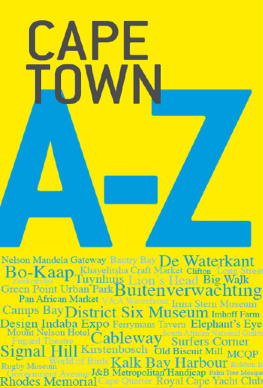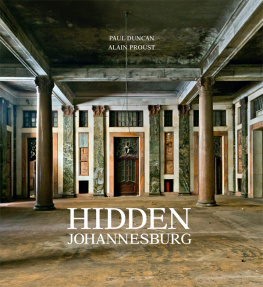
HIDDEN
CAPE TOWN

HIDDEN
CAPE TOWN
PAUL DUNCAN
ALAIN PROUST
ACKNOWLEDGEMENTS
The author would like to thank the following for their help in making this book possible: Abubakr Shabudien, Discover Islam Centre, Cape Town; Alf Rhoodie, Lodge de Goede Hoop; Anita Shaw, Centre for the Book; Basil Bey, Bishops Diocesan College; Captain Francois Morkel, Castle of Good Hope; Captain John Dorrington, Cape Town Rifles (Dukes); Captain John Manning, Cape Town Rifles (Dukes); Celeste Vorster, NGK Tafelberg; Christopher Peter, Director, Irma Stern Museum; Cynthia Court, City Hall; David Hart, Environmental Resource Management Department, City of Cape Town; Deon van Zyl, GK Hof Street; Mandla Matyumza, Centre for the Book; Dr Petre Prins, Prins & Prins Diamonds; Esther Esmyol, Iziko Museums of Cape Town; Ethne Julius, New Somerset Hospital; Fr Nikolai, Greek Orthodox Cathedral; Franklin James, St Georges Cathedral; Hayden Proud, Iziko Museums of Cape Town; Hayley Bond, Amazing Spaces; Ingrid Pakendorf, Evangelical Lutheran Church; Pier and Jo-Marie Rabe; Linda Ruhle, Evangelical Lutheran Church; Lisa Dyason, Lisa Dyason Communications; Louise Ings; Lucy Campbell; Melody Kleinsmith, Iziko Museums of Cape Town; Major Stephen Brimacombe MMM, Cape Town Rifles (Dukes); Mary van Blommenstein, Curator: UCT Works of Art Collection and UCT Irma Stern Museum; Nikki Heath; Penny Murdock, Prins & Prins; Revd Dr Pieter Bingle, Gereformeerde Kerkgebou, Hof Street; Solly Burger; Tanya Barben, Curator, Rare Books and Special Collections, UCT; Wieke van Delen, Iziko Museums of Cape Town; Yasmine Jacobs.
INTRODUCTION

Sculptor Anton Anreiths work can be found in a number of Cape Towns historic buildings, including the Lodge de Goede Hoop, where his Bereavement, depicting a widow mourning the loss of her son, survived a fire in 1892.
T his is a book about Cape Towns interiors. Its about all kinds of places, from public buildings to centres of learning, places of worship to museums, that perhaps it never occurred to you to pop into, even just for a quiet moment. Spanning the centuries from the 17th to the 20th, the range is enormous. This is the book you dont have.
Cape Town has a rich architectural heritage. Have you ever stopped for a moment and wondered what lies beyond the faades of the buildings you most probably drive past every day? Our city, like any other, is often just the wallpaper in our lives, and yet theres artistic, political, social, cultural, commercial and scientific life going on in those places; sometimes in extraordinary interiors. They might be characterized by a magisterial dome, a set of frescoes, a period look, a carved staircase, a collection of furniture, or a set of tiles. Hidden Cape Town is about these places, many of them the unsung heroes providing the backdrop to public life.
Ive tried to stick to the citys centre, although thats been quite hard when the occasional outpost in one of the old suburbs was too tempting to exclude. Groote Schuur is one, Welgelegen another. Theres probably another book anyway. Hidden Cape Town Part 2 could easily be filled with buildings peppering the route to Simons Town. Theres also easily a book on Cape Towns many churches. Ive cherry-picked places to feature from a long list of contenders, trying to highlight excellence over the commonplace, or the unusual over those of which there may be many other examples. Others Ive disregarded, not because Im a philistine, but because their intrinsic value is debatable or their interiors have nothing to contribute, either because theyve changed irretrievably or because theyve gone.
The title, Hidden Cape Town, could imply that the places you see featured are intentionally hidden from view. In most cases, as I discovered, this simply isnt the case. Many are not inaccessible either; its just that as everybody rushes past getting on with life, there isnt much thought for what lies beyond a familiar entrance. I suppose this is inevitable, given that central Cape Town is only now coming back to life after decades as a place to avoid. What has survived is often nothing short of miraculous if you think about what has already been lost and what we have nearly lost.
Some places are well known and celebrated because theyre great buildings with magnificent interiors. One is the Evangelical Lutheran Church in Strand Street, where Anton Anreiths massive statues of Hercules hold up a pulpit. While these sculptures are a reason to visit, so is the fact that its interior is virtually untouched by the passage of time and new discoveries are constantly being made in its archives. Another wonderful building is the former Metropolitan Methodist Church in Greenmarket Square. Now called the Central Methodist Mission, its regarded as a masterpiece of Gothic Revival architecture both inside and out. And theres the Old Mutual Building, which, although difficult to get into, is regarded internationally as an iconic piece of Art Deco.
Others are popularly visited for their celebrated contents. The museum in Koopmans-de Wet House is one, the Old Town House, housing the Michaelis Collection of Old Master Dutch and Flemish paintings is another. Go and see Frans Halss Portrait of a Woman: could this be one of the most significant paintings in Cape Town? But what about the portrait of Theodorus Bas Jacobi, also in the Michaelis Collection? Only recently it was confirmed as being the work of Jacob Adriaensz Backer one of Rembrandts more illustrious competitors and a sought-after and highly fashionable artist in his own day. After 400 years in obscurity, this painter has re-emerged from the shadows and this portrait, whose authorship has long been shrouded in mystery, is now something to celebrate. Are there other treasures lurking in this magnificent collection of Old Master paintings that costs only R10 to visit?

Many of the interior furnishings at Groote Schuur survive, along with period fittings and embellishments, but perhaps the time has come to dispense with later intrusions like the wall-to-wall carpet.
There are places that are less well known, other than to those who use them. The Lodge de Goede Hoop is one, Herbert Bakers Welgelegen is another. Here hang James Durdans paintings; the only record of what Bakers interiors looked like when the Currey family lived there. And then theres the 18th-century Huguenot House in Loop Street, now the home of Prins & Prins Diamonds. Its past was painstakingly unravelled as layers of old paint were peeled away to reveal the remains of a previously magnificent range of decorated interiors.
Theres the Nederlandse Gereformeerde Kerk Tafelberg in Buitenkant Street which, whenever you drive past, is locked and silent though clearly not abandoned because its kept in good condition. Curiously, it doesnt even look like a church. Get inside permission is given if you go to the office that you can only get to via the multi-storey carpark next door and the massive hall-church with its hammer beam roof takes your breath away. Maybe Ive just been blind all these years, but I never knew it was there. A series of small associated rooms are still painted in shades of Victorian brown with furnishings to match. Another of Cape Towns secrets is the interior of the Gereformeerde Kerk Hof Street, a work from the 1950s by that seminal Afrikaans architect Gerard Moerdyk. Utterly pure in its simple modernity, its gently curving lines are a poetic rendition of a liturgical formula that needed expression through a centrally focused auditorium. Nothing inside it is out of place. Its as beautiful now as the day it was completed. Hidden amongst the trees alongside the Mount Nelsons gates, it stands detached, silent and unobtrusive.















